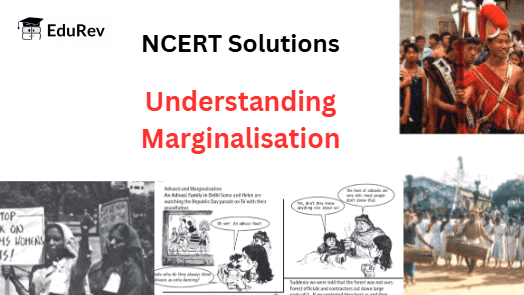NCERT Solutions for Class 8 Civics Chapter 7 - Understanding Marginalisation

Exercises ( Page 73)
Q1. Write in your own words two or more sentences of what you understand by the word ‘marginalisation’.
Ans: The word ‘marginalisation’ simply means exclusion from the mainstream. Marginalisation of any community or a person can be because of many reasons like -
(a) Speaking a different language,
(b) Following different customs,
(c) Belonging to different religious group from the majority community etc.
Marginalisation is linked to experiencing disadvantage, prejudice, poverty and powerlessness. It is a complex phenomenon which results into a low social status, not having equal access to education and other resources.
Q2. List two reasons why Adivasis are becoming increasingly marginalised.
Ans: The two reasons why Adivasis are becoming increasingly marginalised are:
- Misconceptions: Many people wrongly view Adivasis as exotic, primitive, and backward.
- Resistance to Change: Adivasis are often blamed for their lack of progress, as they are seen as resistant to new ideas.
Q3. Write one reason why you think the Constitution’s safeguards to protect minority communities are very important?
Ans: The safeguards to protect minority communities are necessary because the majority community may culturally dominate the minority communities, and the minority communities might become marginalised.
Q4. Re-read the section on Minorities and Marginalisation. What do you understand by the term minority?
Ans: A minority refers to a community that is numerically small compared to the larger population. This term often applies to specific religious or ethnic groups that have a lower percentage in society.
The Constitution of India offers protections for linguistic and religious minorities as part of its fundamental rights. These safeguards ensure that minorities do not experience disadvantage or discrimination.
In India, groups such as Christians, Sikhs, and Muslims are recognised as minorities. The Constitution aims to protect their cultural identity and promote equality and justice.
Q5. You are participating in a debate where you have to provide reasons to support the following statement: ‘Muslims are a marginalised community’. Using the data provided in this chapter, list two reasons that you would give.
Ans: According to the data presented, the Muslim community in India is considered marginalised for the following reasons:
The literacy rate among Muslims is only 59%, which is the lowest compared to other religious groups:
- Hindus: 65%
- Sikhs: 70%
- Buddhists: 73%
- Christians: 80%
- Jains: 94%
- Only 3% of Muslims are represented in the prestigious Indian Administrative Service (IAS).
These statistics highlight the socio-economic challenges faced by the Muslim community in India.
Q6. Imagine that you are watching the Republic Day parade on TV with a friend and she remarks, “Look at these tribals. They look so exotic. And they seem to be dancing all the time”. List three things that you would tell her about the lives of Adivasis in India.
Ans: The common perceptions of Adivasis in India are often misleading. Here are three important points to consider:
- Adivasis have rich and diverse lives that are not well understood by the general public.
- They are frequently portrayed in colourful costumes and dancing, which oversimplifies their culture.
- Many people mistakenly view Adivasis as exotic, primitive, and resistant to development, ignoring their struggles and contributions.
Q7. In the storyboard you read about how Helen hopes to make a movie on the Adivasi story. Can you help her by developing a short story on Adivasis?
Ans: Helen may find the following story useful.
There used to be an adivasi community living their life freely in the forest. They take care of the forest and in return the forest provides them with all the necessary resources. One day, the government decided to start a ‘Development Project’ and ‘modernize’ the lives of the adivasi community.
The people of that community were very happy earlier but soon they realised that they would lose everything they have in return to nothing, in this ‘Development Project’. They protested and tried to raise their voices against the orders but nobody came forward to help them. Eventually goons were sent to beat and threatened the adivasi people to leave their land. The story ends with the adivasi family who used to have everything, now have nothing and are crushed under the stress and betrayal by the people in power.
Q8. Would you agree with the statement that economic marginalisation and social marginalisation are interlinked? Why?
Ans: Yes, economic and social marginalization is interlinked.
- Dalits and tribals were considered a lower class of society.
- They are living in separate areas of villages. Tribals are living in remote areas.
- They were not getting a proper education, so not good jobs.
- When they do not get opportunities they remain economically weak and do not get an education and this circle continues.
|
69 videos|431 docs|46 tests
|
FAQs on NCERT Solutions for Class 8 Civics Chapter 7 - Understanding Marginalisation
| 1. What is marginalisation and how does it affect communities in India? |  |
| 2. How do government policies address the issue of marginalisation? |  |
| 3. What role does education play in overcoming marginalisation? |  |
| 4. How can society contribute to reducing marginalisation? |  |
| 5. What are some common misconceptions about marginalised groups? |  |

















